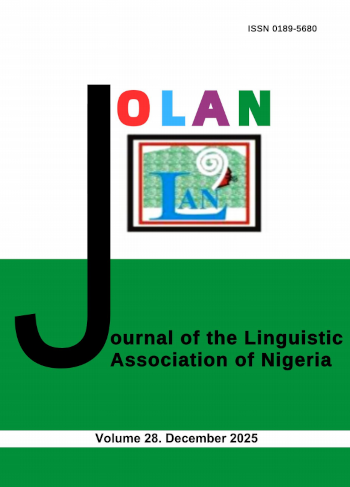Linguistic Framing in the Reportage of Obasanjo’s Letter to President Buhari
Keywords:
media influences, framing, Obasanjo, President Buhari, news reportingAbstract
Reporters use different strategies to present news not only to inform or capture the attention of the readers but also to dictate what to think and debate. They set agenda for discussion and frame part of a news to engender public discussion and opinion. Scholars have worked on framing in the print and electronic media. This work focuses on how the media present the letter by former President Olusegun Obasanjo to the incumbent President, Muhammadu Buhari by investigating the use and implication of framing on social media. Social media has become an important avenue for national discourse because it allows open and wide range readers participation unlike before. Framing theory and textual analysis was adopted as analytical technique. In a bid to examine the framing strategy and choice of words used in reporting the former President’s letter, different news headlines sourced from websites of various newspapers were documented. Ten headlines were discussed. Reporters utilized their adept penmanship to focus various part of the letter to reinforce covet and overt meaning through different framing strategies. Thereby the wheel of public opinion is largely at the media’s disposal and could be wielded at will if unchecked. We realised that the media were able to control the discourse on the letter through different framing technique. Our recommendation therefore includes in-depth knowledge of reporting and objectivity because this type of strategy is capable of causing and aggravating crisis. It is also capable of undermining an important aspect of event as experienced in the case understudy.
References
Akintayo, M.O. and Isola, O.O.2012. Media representation of non-state armed and terrorist groups in Nigeria. International Journal of Social Science Tomorrow. 46-55. New York: Society for Promoting International Research and Innovation
Amenaghawon, F. 2016. Framing of the Niger Delta conflict in selected Nigerians Newspapers. Thesis. Communication and Language Arts. Arts. University of Ibadan.
Asemah, E.S. 2011. Mass media in the contemporary society. Jos: University press.
Babalola E.T. 2002. Newspapers as instrument for building literature communities: The Nigerian experience. Nordic Journal of African Studies11.3.2002:402-410
Ardèvol-Abreu, A. 2015. “Framing theory in communication research in Spain. Origins, development and current situation”. Revista Latina de Comunicación Social, 70, pp. 423 to 450. http://www.revistalatinacs.org/070/paper/1053/23en.html, DOI: 10.4185/RLCS-
-1053en
Baran, S. J. and Davis, D. K. 2009. Mass communication theory: Foundations, Format and Future(5th Ed). Boston: Wadsworth Cengage Learning.
Chong, D. and Druckman, N. J. 2007. A Theory of framing and opinion formation in competitive elite environment. Journal of Communication. 57. 99-118.
Chiluwa, I. Media construction of socio-political crises in Nigeria. Journal of Language and Politics 10.1. 2011a:88–108.
Entman, R. M. 1993. Framing: toward clarification of a fractured paradigm. Journal of Communication. 43. 4: 51-58.
Gamson W.A. 1990. News as framing: comments on Graber. American Behavioral Scientist. 33. 2: 157-161.
Gamson, W. A. and Modigliani, A. 1989. The changing culture of affirmative action. Research in Political Sociology: A Research annual. Eds. Braungart, R. G. andBraungart, M. M. 137 - 138.
Goffman, E. (1974). Frame analysis: An essay on the organization of experience. New York: Harper & Row.
Gorp, V. B. 2007. The constructionist approach to framing: bringing culture back. Journal of Communication.57:60-78.
Merilainen, N. and Vos, M. 2011. Framing issues in the public debate of human rights. Corporate Communication .16. 2010: 293-310.
Nelson, T. E, et al. 1997. Media framing of a civil liberties conflict and its effect on tolerance. American Political Science Review. 567-582.
Noakes, J. A and Wilkins, K.G 2002. Shifting frames of the Palestinian movement in US news, Media, Culture & Society © 2002 SAGE Publications (London, Thousand Oaks and New Delhi), Vol. 24: 649–671 [0163-4437(200209)24:5;649–671;026557]
Schmitz, F.M; Filipone, P &Elderman, M, E .(2003). Social Representation of Attention Hyperactivity Disorder. Culture and Psychology. 9. 4:383-406.
Scheufele, D. A. Framing as a theory of media effects. Journal of Communication.49. 1999:103 – 122.
Scheufele, D. A. and Tewksbury D. 2007. Framing, Agenda Setting, and Priming: The evolution of three Media Effects Models. Journal of Communication. 57. 1: 9–20.
Soni et al. 2014. Modeling Factuality Judgments in Social Media Text, Proceedings of the 52nd Annual Meeting of the Association for Computational Linguistics (Short Papers), pages 415–420, Baltimore, Maryland, USA, June 23-25 2014. 2014 Association for
Computational Linguistics
Valkenburg et al. 1999. What do children value in entertainment programs? A cross-cultural investigation; Journal of communication. DOI: 10.1111/j.1460-2466. 1999.tb02790.x.
Westlund, N. J. 2016. Law enforcement framing on social media A comparative frame analysis of the police forces in Sweden and China and their presence on social media services Facebook and Sina Weibo, Supervisor GöranSvensson Department of Informatics and Media Master Programme in Social Sciences, Digital Media and Society Spring 2016
Zilman, D.1994. Media Effects: Advances in Theory and Research. New Jersey: Lawrence Erlbaum Associates.














